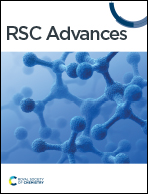A simple method for the synthesis of copper nanoparticles from metastable intermediates†
Abstract
Copper nanoparticles have attracted a wide attention because of their low cost and high specific surface area. At present, the synthesis of copper nanoparticles has the problems of complicated process and environmentally unfriendly materials like hydrazine hydrate and sodium hypophosphite that would pollute water, harm human health and may even cause cancer. In this paper, a simple and low-cost two-step synthesis method was used to prepare highly stable and well-dispersed spherical copper nanoparticles in solution with a particle size of about 34 nm. The prepared spherical copper nanoparticles were kept in solution for one month without precipitation. Using non-toxic L-ascorbic acid as the reducing and secondary coating agent, polyvinylpyrrolidone (PVP) as the primary coating agent, and NaOH as the pH modulator, the metastable intermediate CuCl was prepared. Due to the characteristics of the metastable state, copper nanoparticles were rapidly prepared. Moreover, to improve the dispersibility and antioxidant, the PVP and L-ascorbic acid were used to coat the surface of copper nanoparticles. Finally, the mechanism of the two-step synthesis of copper nanoparticles was discussed. This mechanism mainly relies on the two-step dehydrogenation of L-ascorbic acid to obtain copper nanoparticles.



 Please wait while we load your content...
Please wait while we load your content...